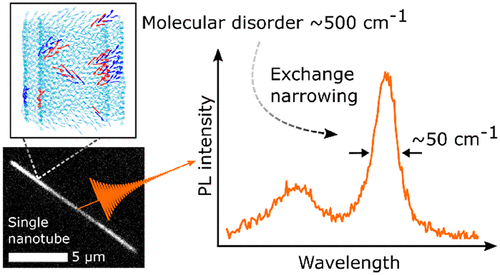当前位置:
X-MOL 学术
›
J. Am. Chem. Soc.
›
论文详情
Our official English website, www.x-mol.net, welcomes your feedback! (Note: you will need to create a separate account there.)
Molecular versus excitonic disorder in individual artificial light-harvesting systems
Journal of the American Chemical Society ( IF 15.0 ) Pub Date : 2020-09-26 , DOI: 10.1021/jacs.0c07392 Björn Kriete 1 , Anna S. Bondarenko 1 , Riccardo Alessandri 1, 2 , Ilias Patmanidis 2 , Victor V. Krasnikov 1 , Thomas L. C. Jansen 1 , Siewert J. Marrink 1, 2 , Jasper Knoester 1 , Maxim S. Pshenichnikov 1
Journal of the American Chemical Society ( IF 15.0 ) Pub Date : 2020-09-26 , DOI: 10.1021/jacs.0c07392 Björn Kriete 1 , Anna S. Bondarenko 1 , Riccardo Alessandri 1, 2 , Ilias Patmanidis 2 , Victor V. Krasnikov 1 , Thomas L. C. Jansen 1 , Siewert J. Marrink 1, 2 , Jasper Knoester 1 , Maxim S. Pshenichnikov 1
Affiliation

|
Natural light-harvesting antennae employ a dense array of chromophores to optimize energy transport via the formation of delocalized excited states (excitons), which are critically sensitive to spatio-energetic variations of the molecular structure. Identifying the origin and impact of such variations is highly desirable for understanding and predicting functional properties yet hard to achieve due to averaging of many overlapping responses from individual systems. Here, we overcome this problem by measuring the heterogeneity of synthetic analogues of natural antennae–self-assembled molecular nanotubes–by two complementary approaches: single-nanotube photoluminescence spectroscopy and ultrafast 2D correlation. We demonstrate remarkable homogeneity of the nanotube ensemble and reveal that ultrafast (∼50 fs) modulation of the exciton frequencies governs spectral broadening. Using multiscale exciton modeling, we show that the dominance of homogeneous broadening at the exciton level results from exchange narrowing of strong static disorder found for individual molecules within the nanotube. The detailed characterization of static and dynamic disorder at the exciton as well as the molecular level presented here opens new avenues in analyzing and predicting dynamic exciton properties, such as excitation energy transport.
中文翻译:

个体人工光收集系统中的分子与激子紊乱
自然光捕获天线采用密集的发色团阵列,通过离域激发态(激子)的形成来优化能量传输,这些激发态对分子结构的空间能量变化非常敏感。识别这种变化的起源和影响对于理解和预测功能特性是非常需要的,但由于对来自单个系统的许多重叠响应进行平均而难以实现。在这里,我们通过两种互补的方法测量天然天线合成类似物的异质性——自组装分子纳米管——克服了这个问题:单纳米管光致发光光谱和超快二维相关。我们展示了纳米管集合的显着同质性,并揭示了激子频率的超快(~50 fs)调制控制了光谱展宽。使用多尺度激子建模,我们表明激子水平上均匀加宽的优势是由于纳米管内单个分子发现的强静态无序的交换变窄所致。激子静态和动态无序的详细表征以及此处介绍的分子水平为分析和预测动态激子特性(例如激发能量传输)开辟了新途径。
更新日期:2020-09-26
中文翻译:

个体人工光收集系统中的分子与激子紊乱
自然光捕获天线采用密集的发色团阵列,通过离域激发态(激子)的形成来优化能量传输,这些激发态对分子结构的空间能量变化非常敏感。识别这种变化的起源和影响对于理解和预测功能特性是非常需要的,但由于对来自单个系统的许多重叠响应进行平均而难以实现。在这里,我们通过两种互补的方法测量天然天线合成类似物的异质性——自组装分子纳米管——克服了这个问题:单纳米管光致发光光谱和超快二维相关。我们展示了纳米管集合的显着同质性,并揭示了激子频率的超快(~50 fs)调制控制了光谱展宽。使用多尺度激子建模,我们表明激子水平上均匀加宽的优势是由于纳米管内单个分子发现的强静态无序的交换变窄所致。激子静态和动态无序的详细表征以及此处介绍的分子水平为分析和预测动态激子特性(例如激发能量传输)开辟了新途径。



























 京公网安备 11010802027423号
京公网安备 11010802027423号